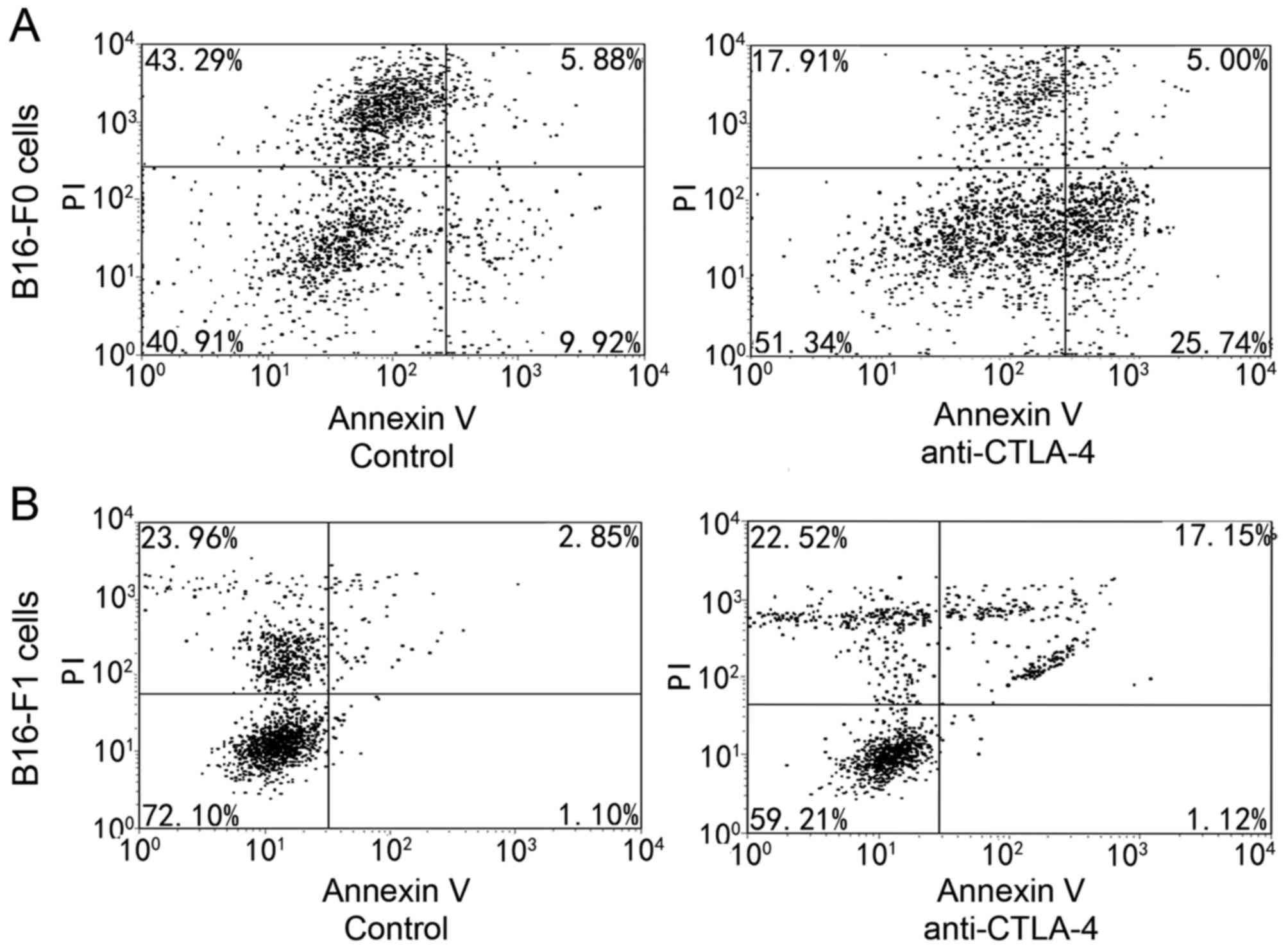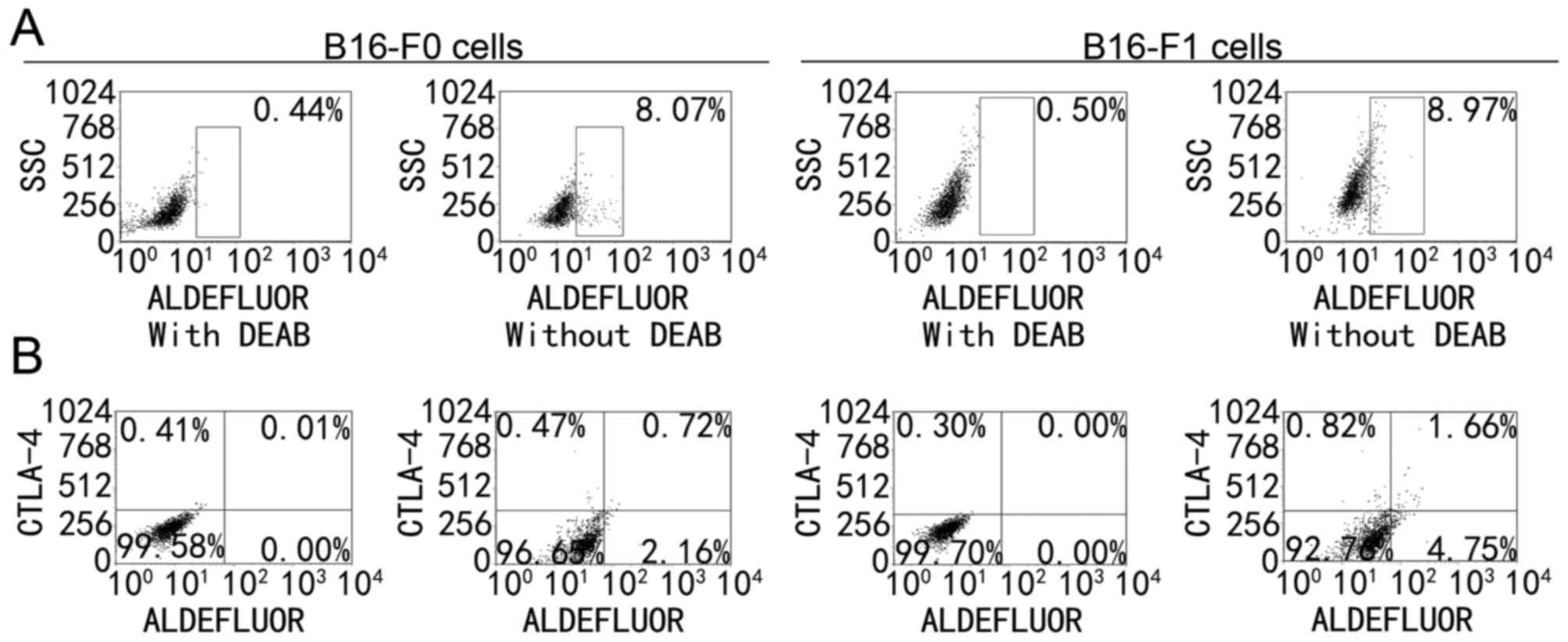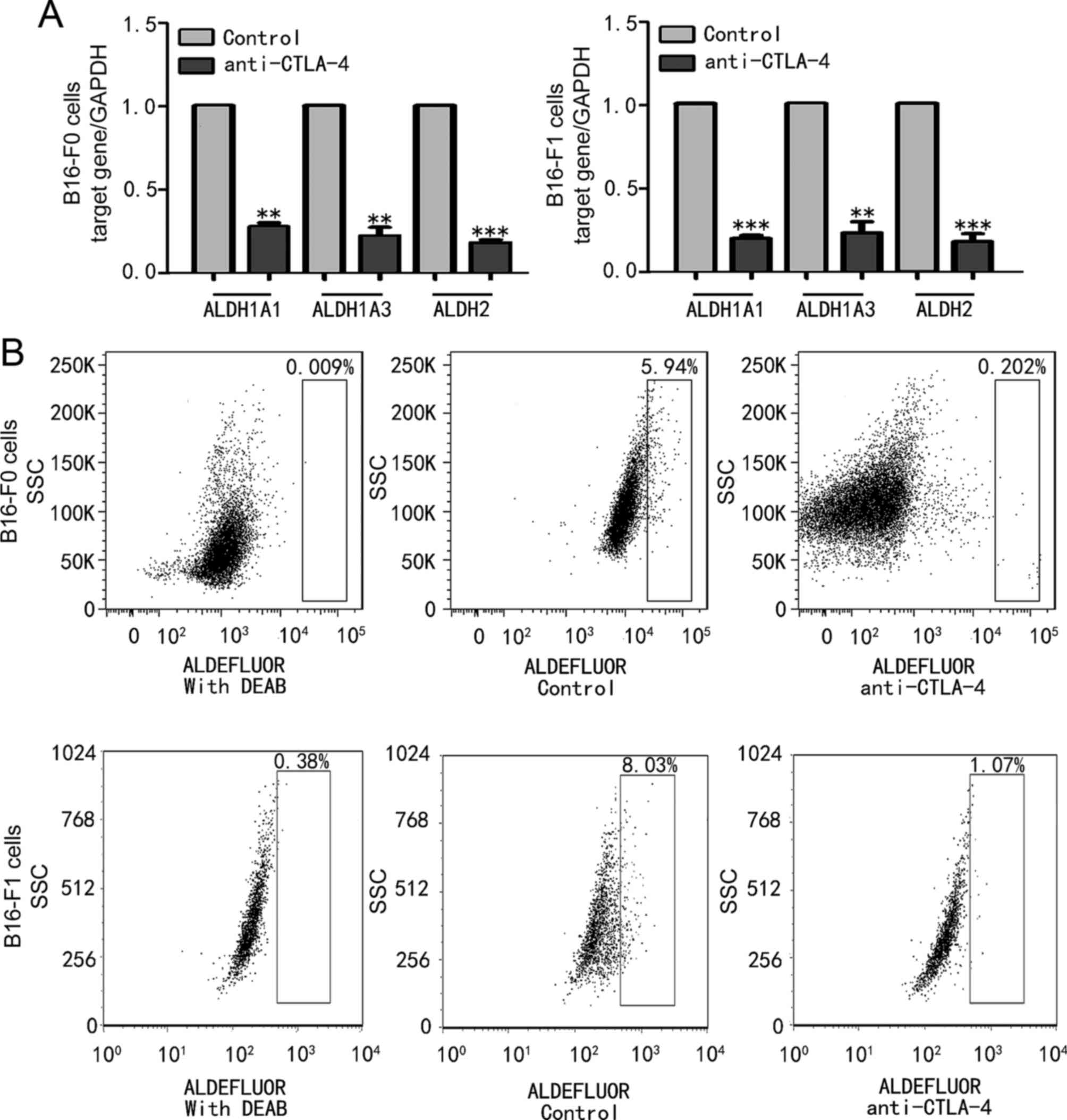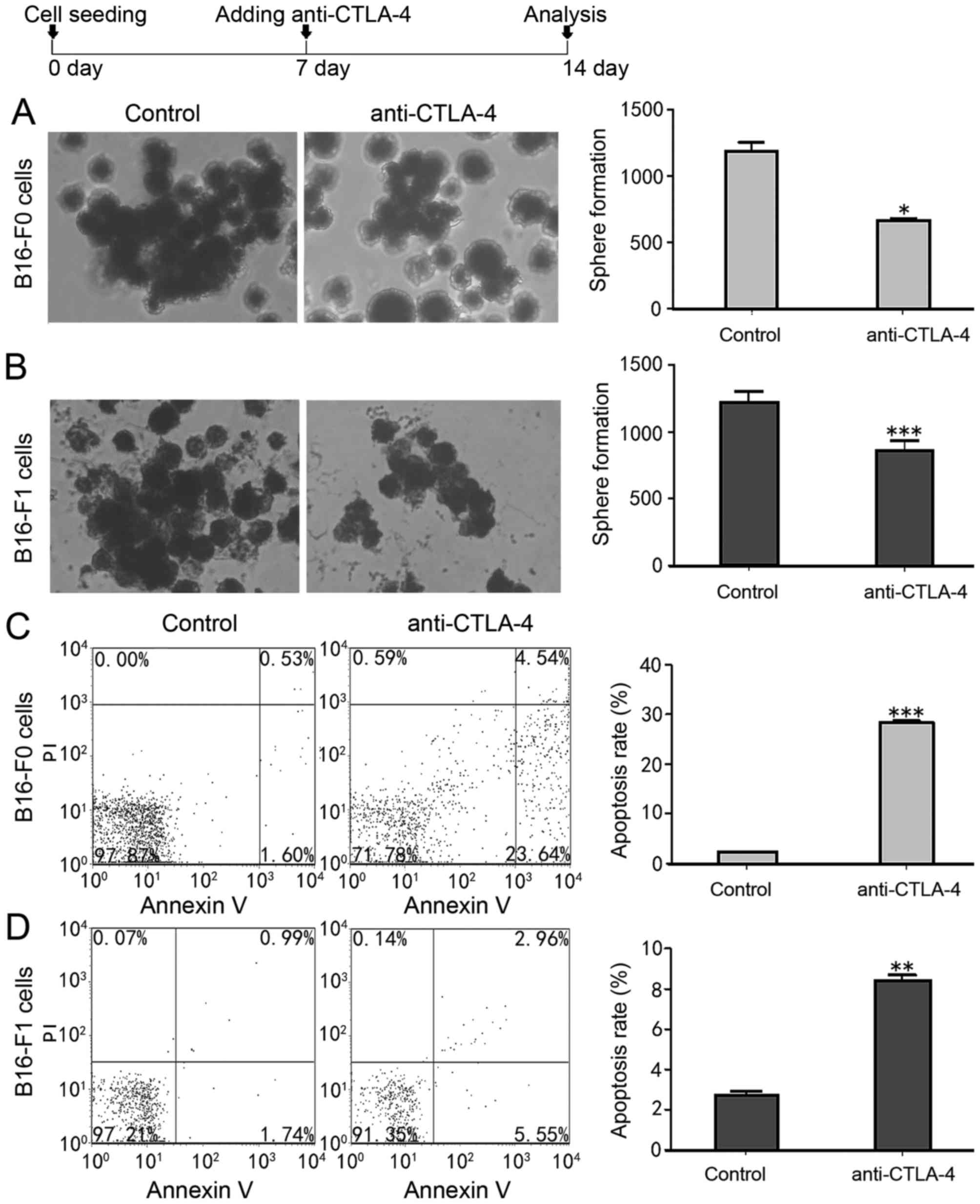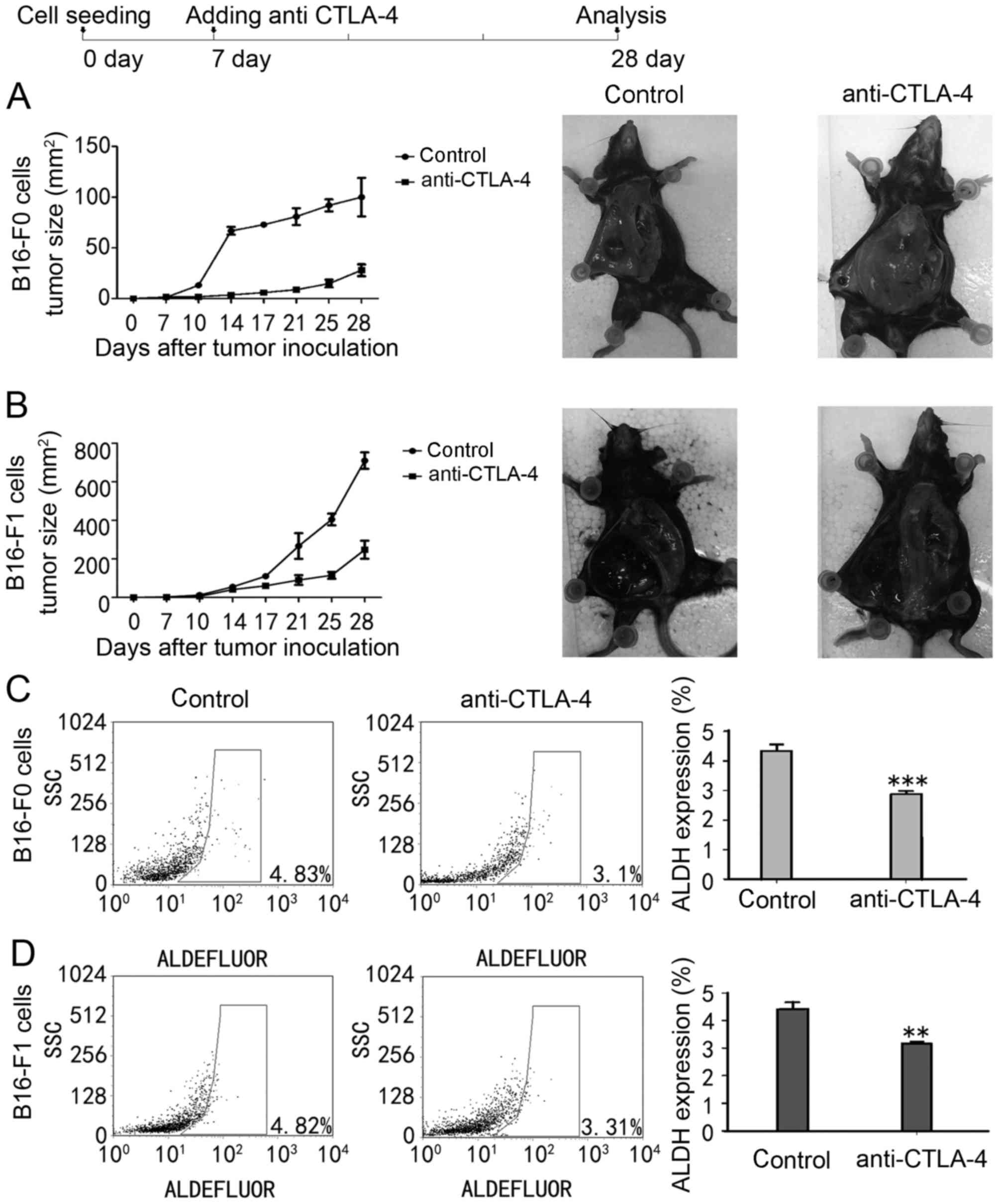|
1
|
Gray-Schopfer V, Wellbrock C and Marais R:
Melanoma biology and new targeted therapy. Nature. 445:851–857.
2007. View Article : Google Scholar : PubMed/NCBI
|
|
2
|
Murphy GF, Wilson BJ, Girouard SD, Frank
NY and Frank MH: Stem cells and targeted approaches to melanoma
cure. Mol Aspects Med. 39:33–49. 2014. View Article : Google Scholar : PubMed/NCBI
|
|
3
|
Hirohashi Y, Torigoe T, Tsukahara T,
Kanaseki T, Kochin V and Sato N: Immune responses to human cancer
stem-like cells/cancer-initiating cells. Cancer Sci. 107:12–17.
2016. View Article : Google Scholar : PubMed/NCBI
|
|
4
|
Brunner MC, Chambers CA, Chan FK, Hanke J,
Winoto A and Allison JP: CTLA-4-mediated inhibition of early events
of T cell proliferation. J Immunol. 162:5813–5820. 1999.PubMed/NCBI
|
|
5
|
Wu L, Yun Z, Tagawa T, Rey-McIntyre K and
de Perrot M: CTLA-4 blockade expands infiltrating T cells and
inhibits cancer cell repopulation during the intervals of
chemotherapy in murine mesothelioma. Mol Cancer Ther. 11:1809–1819.
2012. View Article : Google Scholar : PubMed/NCBI
|
|
6
|
Whiteside TL: Regulatory T cell subsets in
human cancer: Are they regulating for or against tumor progression?
Cancer Immunol Immunother:. 63:67–72. 2014. View Article : Google Scholar : PubMed/NCBI
|
|
7
|
Lindau D, Gielen P, Kroesen M, Wesseling P
and Adema GJ: The immunosuppressive tumour network: Myeloid-derived
suppressor cells, regulatory T cells and natural killer T cells.
Immunology. 138:105–115. 2013. View Article : Google Scholar : PubMed/NCBI
|
|
8
|
Hodi FS, O'Day SJ, McDermott DF, Weber RW,
Sosman JA, Haanen JB, Gonzalez R, Robert C, Schadendorf D, Hassel
JC, et al: Improved survival with ipilimumab in patients with
metastatic melanoma. N Engl J Med. 363:711–723. 2010. View Article : Google Scholar : PubMed/NCBI
|
|
9
|
Robert C, Thomas L, Bondarenko I, O'Day S,
Weber J, Garbe C, Lebbe C, Baurain JF, Testori A, Grob JJ, et al:
Ipilimumab plus dacarbazine for previously untreated metastatic
melanoma. N Engl J Med. 364:2517–2526. 2011. View Article : Google Scholar : PubMed/NCBI
|
|
10
|
Suwalska K, Pawlak E, Karabon L,
Tomkiewicz A, Dobosz T, Urbaniak-Kujda D, Kuliczkowski K, Wolowiec
D, Jedynak A and Frydecka I: Association studies of CTLA-4, CD28
and ICOS gene polymorphisms with B-cell chronic lymphocytic
leukemia in the Polish population. Hum Immunol. 69:193–201. 2008.
View Article : Google Scholar : PubMed/NCBI
|
|
11
|
Monne M, Piras G, Palmas A, Arru L,
Murineddu M, Latte G, Noli A and Gabbas A: Cytotoxic T-lymphocyte
antigen-4 (CTLA-4) gene polymorphism and susceptibility to
non-Hodgkin's lymphoma. Am J Hematol. 76:14–18. 2004. View Article : Google Scholar : PubMed/NCBI
|
|
12
|
Yu H, Yang J, Jiao S, Li Y, Zhang W and
Wang J: Cytotoxic T lymphocyte antigen 4 expression in human breast
cancer: Implications for prognosis. Cancer Immunol Immunother.
64:853–860. 2015. View Article : Google Scholar : PubMed/NCBI
|
|
13
|
Khaghanzadeh N, Erfani N, Ghayumi MA and
Ghaderi A: CTLA4 gene variations and haplotypes in patients with
lung cancer. Cancer Genet Cytogenet. 196:171–174. 2010. View Article : Google Scholar : PubMed/NCBI
|
|
14
|
Laurent S, Queirolo P, Boero S, Salvi S,
Piccioli P, Boccardo S, Minghelli S, Morabito A, Fontana V, Pietra
G, et al: The engagement of CTLA-4 on primary melanoma cell lines
induces antibody-dependent cellular cytotoxicity and TNF-alpha
production. J Transl Med. 11:1082013. View Article : Google Scholar : PubMed/NCBI
|
|
15
|
Hadinia A, Hossieni SV, Erfani N,
Saberi-Firozi M, Fattahi MJ and Ghaderi A: CTLA-4 gene promoter and
exon 1 polymorphisms in Iranian patients with gastric and
colorectal cancers. J Gastroenterol Hepatol. 22:2283–2287. 2007.
View Article : Google Scholar : PubMed/NCBI
|
|
16
|
Pawlak E, Karabon L, Wlodarska-Polinska I,
Jedynak A, Jonkisz A, Tomkiewicz A, Kornafel J, Stepien M,
Ignatowicz A, Lebioda A, et al: Influence of CTLA-4/CD28/ICOS gene
polymorphisms on the susceptibility to cervical squamous cell
carcinoma and stage of differentiation in the Polish population.
Hum Immunol. 71:195–200. 2010. View Article : Google Scholar : PubMed/NCBI
|
|
17
|
Zhang XF, Pan K, Weng DS, Chen CL, Wang
QJ, Zhao JJ, Pan QZ, Liu Q, Jiang SS, Li YQ, et al: Cytotoxic T
lymphocyte antigen-4 expression in esophageal carcinoma:
Implications for prognosis. Oncotarget. 7:26670–26679.
2016.PubMed/NCBI
|
|
18
|
Contardi E, Palmisano GL, Tazzari PL,
Martelli AM, Falà F, Fabbi M, Kato T, Lucarelli E, Donati D, Polito
L, et al: CTLA-4 is constitutively expressed on tumor cells and can
trigger apoptosis upon ligand interaction. Int J Cancer.
117:538–550. 2005. View Article : Google Scholar : PubMed/NCBI
|
|
19
|
Dai F, Zhang F, Sun D, Zhang ZH, Dong SW
and Xu JZ: CTLA4 enhances the osteogenic differentiation of
allogeneic human mesenchymal stem cells in a model of immune
activation. Braz J Med Biol Res. 48:629–636. 2015. View Article : Google Scholar : PubMed/NCBI
|
|
20
|
Duarte S, Momier D, Baqué P, Casanova V,
Loubat A, Samson M, Guigonis JM, Staccini P, Saint-Paul MC, De Lima
MP, et al: Preventive cancer stem cell-based vaccination reduces
liver metastasis development in a rat colon carcinoma syngeneic
model. Stem Cells. 31:423–432. 2013. View Article : Google Scholar : PubMed/NCBI
|
|
21
|
Livak KJ and Schmittgen TD: Analysis of
relative gene expression data using real-time quantitative PCR and
the 2(-Delta Delta C (T)) method. Methods. 25:402–408. 2001.
View Article : Google Scholar : PubMed/NCBI
|
|
22
|
Ning N, Pan Q, Zheng F, Teitz-Tennenbaum
S, Egenti M, Yet J, Li M, Ginestier C, Wicha MS, Moyer JS, et al:
Cancer stem cell vaccination confers significant antitumor
immunity. Cancer Res. 72:1853–1864. 2012. View Article : Google Scholar : PubMed/NCBI
|
|
23
|
Choi AR, Park JR, Kim RJ, Kim SR, Cho SD,
Jung JY and Nam JS: Inhibition of Wnt1 expression reduces the
enrichment of cancer stem cells in a mouse model of breast cancer.
Biochem Biophys Res Commun. 425:436–442. 2012. View Article : Google Scholar : PubMed/NCBI
|
|
24
|
Li F, Guo Z, Yu H, Zhang X, Si T, Liu C,
Yang X and Qi L: Anti-tumor immunological response induced by
cryoablation and anti-CTLA-4 antibody in an in vivo RM-1 cell
prostate cancer murine model. Neoplasma. 61:659–671. 2014.
View Article : Google Scholar : PubMed/NCBI
|
|
25
|
Shinoyama M, Ideguchi M, Hayashi H, Doi D,
Hashimoto N, Suzuki M and Takahashi J: Cytotoxic T lymphocyte
antigen 4 immunogloblin promotes neuronal differentiation in the
grafts of embryonic stem cell-derived neural precursor cells.
Neuroscience. 202:484–491. 2012. View Article : Google Scholar : PubMed/NCBI
|
|
26
|
Luo Y, Dallaglio K, Chen Y, Robinson WA,
Robinson SE, McCarter MD, Wang J, Gonzalez R, Thompson DC, Norris
DA, et al: ALDH1A isozymes are markers of human melanoma stem cells
and potential therapeutic targets. Stem Cells. 30:2100–2113. 2012.
View Article : Google Scholar : PubMed/NCBI
|
|
27
|
Topalian SL, Taube JM, Anders RA and
Pardoll DM: Mechanism-driven biomarkers to guide immune checkpoint
blockade in cancer therapy. Nat Rev Cancer. 16:275–287. 2016.
View Article : Google Scholar : PubMed/NCBI
|
|
28
|
Callahan MK, Postow MA and Wolchok JD:
Immunomodulatory therapy for melanoma: Ipilimumab and beyond. Clin
Dermatol. 31:191–199. 2013. View Article : Google Scholar : PubMed/NCBI
|
|
29
|
Ji RR, Chasalow SD, Wang L, Hamid O,
Schmidt H, Cogswell J, Alaparthy S, Berman D, Jure-Kunkel M,
Siemers NO, et al: An immune-active tumor microenvironment favors
clinical response to ipilimumab. Cancer Immunol Immunother.
61:1019–1031. 2012. View Article : Google Scholar : PubMed/NCBI
|



